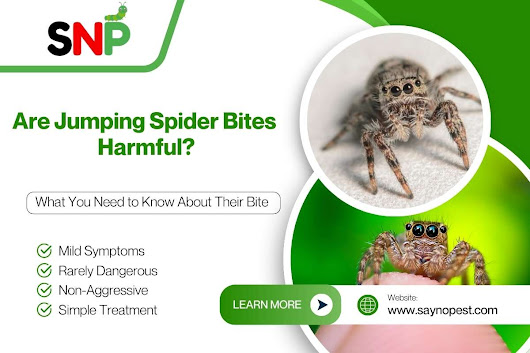Truth About Jumping Spider Bites: Are They Harmful?
Jumping spiders are very attractive members that are found everywhere in the United States. They are known for their excellent eyesight and jumping skills. These tiny hunters are exciting to kids and therefore have often been feared due to a question they raised: Are they dangerous because of their bite? In this article, we will dig out the hidden truth about jumping spiders, identify some major types of jumping spider, and clarify the issue of jumping spider bites. This manual will be good advice for you if you are a homeowner, a gardener, or a nature fan, as it will give you the right and effective information you need to be calm and at ease.
Types of Jumping Spider
More than 300 types of jumping spiders exist in North America that appear and behave differently. The two most common and recognizable species of jumping spider that you may come across are below:- Bold Jumper: The main features of the bold jumper include the black body with small white spots, iridescent green or blue chelicerae, which are scattered all over the U.S. Gardens, houses are built, and also within the homes, especially near windows and doors.
- Zebra Jumper: Zebra jumper is a small-sized species that has a black and white striped body, and this is the most familiar aspect of this species It prefers to be located in the green grasses or a certain low plant location. It is highly popular with arachnologists due to the fact that it is very fast and very nimble when hunting, and to the fact that it looks quite spectacular on account of its strikingly colored aura.
These two kinds of jumping spiders are the trifecta of families that make a great car: they have incredible jumping ability, a powerful vision, and their nature is hunting, not spinning webs.
Are Jumping Spider Bites Harmful?
In the case of a jumping spider, the best part is that they are not thought to cause any harm to people. Understand these pointers for better:- Mild Symptoms: Theoretically speaking, if it happens that a jumping spider bit you, the symptoms would be mild and could be redness of the skin, minor swelling, itching, or a rash that is similar to a mosquito bite. The pain is generally less intense than that created by a bee sting and goes away without treatment in a few hours to a couple of days.
- Venom Facts: The jumping spiders certainly have the venom to conquer their prey, but the venom is of no medical use in the treatment of humans. The focus of their venom is to paralyze the insect, not to harm people.
- Allergic Reactions: The worrying aspect is that the severe reactions to a jumping spider bite are false rumors that can be spread all over the Internet and thus cause unnecessary fear. Although this is not very probable, the bitten person may be one of the people who are highly allergic to insect bites, hence may need medical treatment. Under these circumstances, do not think twice to order the ambulance immediately and initiate the first aid practices in case you actually know how to do it until the assistance comes.
What to Do If Bitten
In case you are sure that a spider has bitten you, a jumping one to be specific, the following are the things you need to do:- First of all, clean the bitten place with soap and water in order to prevent it from being infected.
- Cover the bitten place with a cold compress in order to soothe the pain and reduce the swelling.
- If you feel you need it, take pain medication or antihistamines that are available over the counter.
Do Jumping Spiders Bite Indoors?
Jumping spiders generally like outdoor places like yards, grasslands.They, however, do not infest houses, and going away is what they want, rather than fighting if they meet a human. In case you meet one in your house, be aware that jumping spider bites are still very improbable, and you definitely should not panic.Conclusion
Are jumping spider bites dangerous? The majority of people can rest easy with the answer of no. The jumping spiders are good predatory insects that keep the pest insects at bay and do not have much detrimental bite impact. Learning about the two kinds of jumping spider and the jumping spider bite facts, you can safely co-exist with this amazing creature. So whatever happens, fall back and if you should find yourself bitten, never fear that a little first aid is all that will be required, and serious reactions are so rare as to be a mere impossibility.To simply prevent the presence of spiders in your home and obtain the best professional advice regarding pest control, turn to SAYNOPEST and find everything you need to know and do to care about your household.





Comments
Post a Comment